2013 Ski-Doo Summit X Review – Video

Summit evolves into a mountain super sled
On January 07, 2012, I was in my backyard raking and bagging leaves, trimming tree branches and doing general yard work. The 50-degree weather forced me to wear a hooded sweatshirt and life was strange for a Southeast Idaho winter.
Then winter came.
Through the January weekends of the 21st and 28th, the Snowmobile.com Mountain Team conducted its Powder Sled Evaluations on its fleet of 2012 mountain snowmobiles. Involved in this was our 2012 800 Ski-Doo Summit X 154 with its S-26 handling package and Powder Max II track. At that time, we did not know the Summit X in the famed XP chassis would be relegated to Ski-Doo’s history books.
We move ahead to the annual test ride and photo shoot of the 2013s in West Yellowstone, Mont. The talk in the media camp focused on three topics: Polaris’ 417-pound RMK Pro 155 with belt drive, Ski-Doo’s tMotion rear suspension on the Summit and Cat’s evolving M8 Sno Pro with 2.6-inch paddle track.
Get the Flash Player to see this player. |
Ski-Doo laid in wait.
The test ride days came and the Summits, with the other brand and model mountain sleds, were lined up and the triggers were pulled. By the end of four days of riding and education, our mountain sled crew became fully convinced of four Summit facts. First, the tMotion rear suspension and flexible Powder Max II track are not gimmicks. Second, the pushed forward spindle and ski changes cured the Summit’s front end handling woes. Third, the stood-up handlebar post solved body positioning awkwardness for superb technical riding. And fourth, the foot well changes amplified the handlebar change by giving the rider proper alignment with chassis and track to manipulate the Summit into proper mountain-attack positions.
As added emphasis to the changes, this Summit is no longer dubbed XP but XM.
It is new.
All new.
Let’s begin with what we know. The XM Summit, be it the SP or X, is powered by Ski-Doo’s torque- and horsepower-rich 800R E-TEC with electronic direct fuel injection. This motor for 2013 is in its third year powering the Summit X 800, 2011 being Year One. The nearly 164 horsepower 800 twin cylinder two-stroke is direct fuel-injected, which gives easy starts, throttle pulls and electric motor-like power throughout its RPM band.
Ski-Doo’s new tMotion rear suspension, which will be detailed in a separate feature, is in short, a rear suspension where Ski-Doo’s suspension engineers added a ball joint hinge between the rear arm and the drop link. Split flex points on the front arm further induce controlled roll for responsive and predictable action when attacking a steep slope. The tMotion works in tandem with Ski-Doo’s new Powder Max II track, which incorporates “flexi” technology by molding into the track 12-inch long fiberglass reinforcing rods, leaving the track’s right- and left-side outer two-inches unreinforced, thus allowing the track’s edges to flex up when a sidehill roll is initiated.
What I don’t want you to imagine is this suspension swinging right and left like a school yard swing – it does not. Two degrees each way, for a total of four, is the range. That is rather miniscule, but significant. Not to end here, the tMotion rising-rate motion-ratio rear suspension is smooth and comfortable on the trail. It soaks bumps and keeps the narrow ski-stance planted for trail conquering.
Other mountain specific amenities the XM Summit has is a new footwell and body side panels near the footwells that are open for maneuvering foot and body to attack tree-infested slopes when the snow is deep. Eight inches of added room is given to the rider from this new XM platform, which allows the rider be in line with the track drivers and handlebar post. This is no gimmick, it works.
The new S-36 front suspension, still maintaining a narrow ski-stance of 37.4 inches to 35.7 inches, was redesigned to place the skis and spindles 7mm more forward versus 2012. This, coupled with a moved forward handlebar post, gives the XM Summit X and SP a light and in-control feeling through the bars. Historically, I have voiced the lightest snowmobile on the market, when the Summit was the lightest, felt the heaviest through the bars. Not so anymore, the Summit X and SP are the lightest feeling mountain snowmobiles through the handlebars. There is no arm fatigue when spending the day boondocking in highly technical fashion.
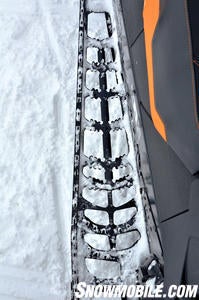 New for the 2013 XM Summit are runningboards that have gaping holes for snow evacuation.
New for the 2013 XM Summit are runningboards that have gaping holes for snow evacuation.
The cockpit is redesigned with a new semi-rigid mountain strap that is a welcome addition. The gauges, which we call standup gauges, are positioned to look up at the rider while you’re standing — which is most of the time. Behind the standup gauges is a warm box to dry gloves or bake goggles for that needed de-fogging. Minimalist controls and protected RER and kill switch keep a rider in the zone.
The XM summit X and SP have new runningboards that are strong and deliver 87 percent more evacuation holes than Ski-Doo’s previous Summit. Above the boards for the Summit X is Ski-Doo’s well-sculptured rounded seat that is firm and tactile. This seat offers some much appreciated rear seat storage. Thank you Ski-Doo. The SP seat is not the X race style seat, but it still has the rear storage.
One aspect manufacturers forget when building mountain snowmobiles is the ski. Ski-Doo has not. I must plug into this piece. The Ski-Doo Summit powder ski works and is a team member to the refined XM chassis.
Now, Ski-Doo, I believe, looked back at its history and asked itself: “When were we king?” The ZX chassis Summit set them up for greatness. The REV Summit, the 2003.5 and 2004 was radical, and the rider forward position began. The XP Summit perhaps was over-engineered. Yes, in its debut, the XP was light, but felt heavy. Handling in the trees was a fight. Then S-36 came along in 2011, and we warmed up to the XP Summit and began feeling good about Ski-Doo’s mountain program. Unbeknownst to us in the press, the two years the S-36 XP Summit Xs were on the snow, the XM Summit was also on the snow being schooled to recapture the Summit legacy.
So, quietly it came.
Were we skeptical of tMotion, FlexEdge track, pushed forward ski spindles and handlebar post? Did we feel it might all be a marketing gimmick? Yes. Are we skeptical now? No.
The Summit X and SP works. Deep powder, tracked up hills, trees and technical riding though the boondocks was a delight. Downhill sidehill maneuvers were effortlessly done. Carving back up a hill from a descent required minimal effort; straddling the seat was all that was needed; dip a shoulder, load the uphill runningboard, unload the downhill side runningboard, and let the Summit carve an arc and up the hill it will go. We noticed we never used the mountain bar, and very seldom did we place both feet on one runningboard.
The Summit cares for its rider. It has flat “look-up” gauges that stare up at its rider when the rider is standing. It has a goggle or glove box behind the gauges and rear seat storage. All are nice.
Test Rider Kevin Allred’s Impressions
As I reviewed my notes from BRP’s tech session held in West Yellowstone before our actual on-snow rides, I counted no less than 18 impressive changes from the XP Summit chassis to the new REV XM platform. These changes represent the most mountain-specific snowmobile I’ve ever seen. Why so much attention to the mountain segment? The last three years the number one selling snowmobiles have been mountain-specific machines. The last two years, the very popular Polaris Pro RMK has enjoyed this honor, and has no doubt caught the attention of its competitors. One thing about being Number One, the competition knows where to set the target. Impressive things happen when things heat up between manufacturers, we as consumers enjoy the benefits, such as these many changes that make this new REV XM Summit what it is.
Due to a storm system, Feb. 27 – Mar. 4, Mother Nature provided us with a whole season’s snapshot of mountain riding, from hard packed windblown snow, to deep powder snow. Wow it was fun. I had to remind myself, “This was work.” Ultimately, the plentiful snow gave us the needed conditions to put the new Summit to the test. My main focus was the new tMotion suspension combined with the Powder Max II track with FlexEdge. But in no way do I discount the other changes. Such as changes in rider position, which allows the rider to align with the handlebars; changes to the ski, as well as the spindles that push the skies 7mm forward. This was immediately noticed and applauded.
After several days of riding, it became very evident to me; these changes work together and make for a very different Summit. When I first read about the tMotion suspension, I pictured something quite complicated and raised concerns about durability. After seeing the tMotion, it is actually very simple in design and leaves me with no durability concerns.
BRP claims the tMotion, combined with FlexEdge track, helps initiate a roll. How much this comes into play I can’t actually say, but this sled requires minimal rider effort to initiate a roll. Once on edge, it maintains the line with confidence regardless of snow conditions. If anything, at first I found myself over riding the REV XM. By the fourth day, I was amazed at the technical maneuvers that can be accomplished by simply standing, counter steering with the handlebars and rolling with the sled.
The Powder Max II track works very well in the deep snow; we discovered this on our 2012 Summit. For 2013 it’s basically the same track, but with the FlexEdge technology. At times last season we felt there was no question the 2.5-inch Powder Max II track was the best performing track. On the 2013 with FlexEdge, it can only be better. The track is powered by a proven drive system, which has seen improvements for 2013 to increase durability. The drive train, coupled with E-TEC 800R power, the new REV-XM Summit is an amazing deep snow player. Regardless of your brand loyalty, if you’re looking at a new ride for the upcoming season this sled deserves serious consideration.
In closing
As Snowmobile.com’s Western Editor, I give Ski-Doo’s Summit X 154 my editor’s choice for best mountain sled. However, I also give this accolade to Polaris’ super light 2013 800 Pro RMK with Quick Drive and its 417 dry weight figure. I can’t overlook lightweight, drive efficiency and incredible power-to-weight. We’ll be chronicling the 800 Pro RMK in a later feature.
But for the upcoming season, I believe the two 2013 supersleds on the snow will be the Summit X 154 and Pro RMK 155. For those who don’t believe the 800 Pro RMK can be equaled, think again. This is going to be an interesting year.
I am not taking the safe way out; in fact this complicates the matter. But, the Summit is not an over-engineered deep powder snowmobile; it is a simplistic mountain snowmobile that accomplishes its goals in an unconventional way. Yes, it may be 40 some odd more pounds heavier than the Pro RMK 155, but go ride it and tell me if this is true. And when you do, you will find its balance, its feathery feel through the bars, and its highly flickable nature, will challenge the concept of which snowmobile is the lightest and most flickable on the snow for season 2013. At our weeklong test ride in West Yellowstone, the XM Summit X and SP accomplished the unexpected.
| 2013 Ski-Doo Summit 800 X Specs | |
| Engine | Rotax E-TEC 800R 799.5cc, liquid-cooled twin; direct injection; 3-D RAVE |
| Horsepower | 164 (Claimed) — Requires Premium unleaded |
| Drive | TRA VII with QRS secondary |
| Front Suspension | Dual A-arm; HPG Plus gas shocks with coil over springs; 8-in travel |
| Rear Suspension | tMotion parallel rail; HPG Plus shocks; up to 16-in travel |
| Length | 127.0 in w/146-in track; 131.3 w/154-in track; 135.6 w/163-in track |
| Width | 42.6 – 44.3 in |
| Height | 53.0 in |
| Ski Stance | Adjustable: 35.7 or 37.4 in |
| Track | PowderMax II with 2.5 lug profile; FlexEdge 16-in width in three available lengths (146, 154, 163) |
| Weight | 454 – 464 lbs (claimed) |
| Fuel Capacity | 10.6 US Gal (Premium unleaded recommended) |
| Features | Electronic reverse; chromoly A-arm suspension; multi-function gauge; aluminum tapered handlebar; “XM” lightweight seat with storage; New Pilot DS2 skis; J-hooks and mountain strap |
| MSRP | Spring Only —Starting at US$11,999 |
Related Reading
2013 Ski-Doo Snowmobile Lineup Unveiled
First Impressions of the 2013 Powder Sleds
2012 Mountain Sled Evaluations: Part 1
2012 Mountain Sled Evaluations: Part 2



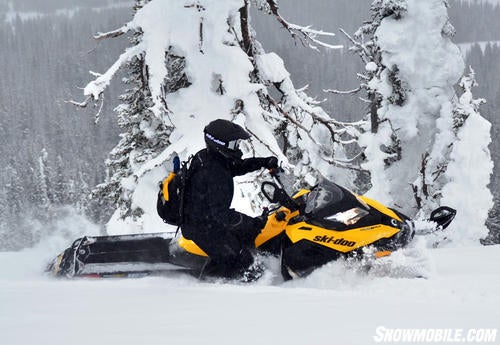
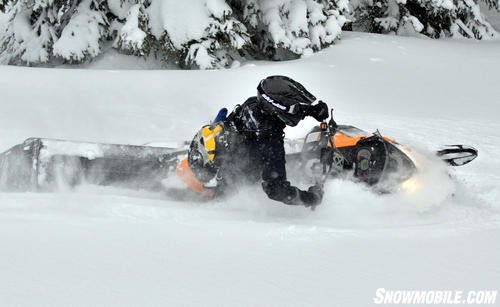
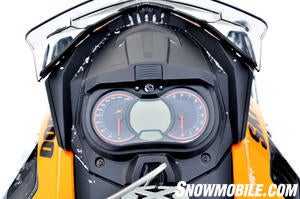
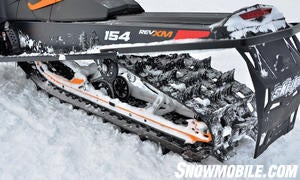
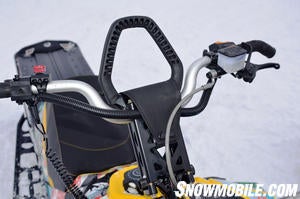
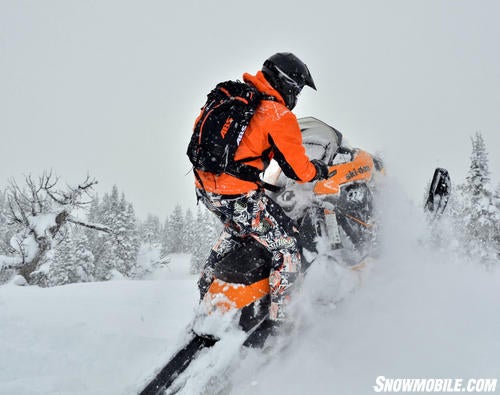





 Your Privacy Choices
Your Privacy Choices